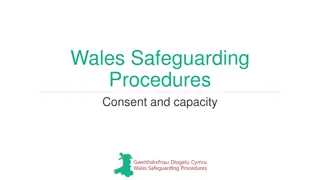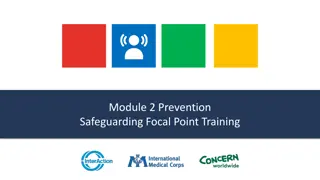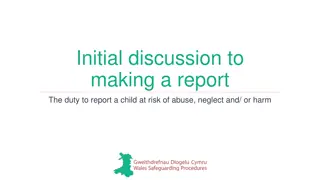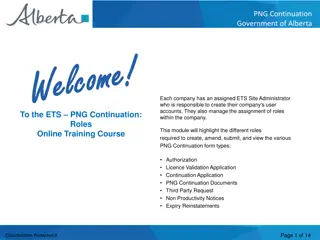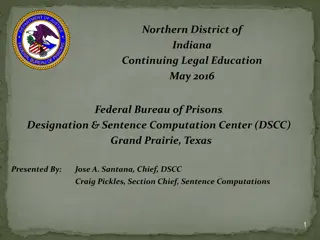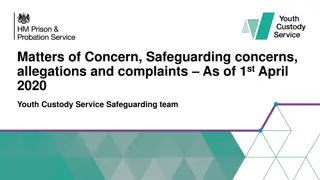Understanding Safeguarding in Prisons: Roles, Responsibilities, and Process
Safeguarding in prisons ensures the safety and protection of detainees from abuse and neglect. This involves a range of activities such as investigation of concerns, cooperation with local authorities, and following a structured safeguarding process in case of suspected harm. Roles and responsibilities are clearly defined between prisons, local authorities, and Safeguarding Adults Boards to ensure effective collaboration and action when safeguarding issues arise in custodial settings.
Download Presentation

Please find below an Image/Link to download the presentation.
The content on the website is provided AS IS for your information and personal use only. It may not be sold, licensed, or shared on other websites without obtaining consent from the author. Download presentation by click this link. If you encounter any issues during the download, it is possible that the publisher has removed the file from their server.
E N D
Presentation Transcript
Effective collaboration Effective collaboration Prisons and Safeguarding Adults Boards Prisons and Safeguarding Adults Boards Mark Godfrey Independent Chair Royal Greenwich Safeguarding Adults Board
What safeguarding means in prison What safeguarding means in prison In prison, safeguarding is an umbrella term to describe all the activity that takes place to ensure prisoners are held safely and securely and protected from abuse and neglect It means taking measures to protect the health, wellbeing and human rights of vulnerable individuals, to enable them to live free from abuse, harm and neglect In custody the duty of care is both positive, a duty to provide, and negative, a duty to prevent Prisons are responsible for the safety of their detainees and the operational policy is set out in a range of documents
Roles and responsibilities Roles and responsibilities Prisons and not local authorities are responsible for investigating safeguarding concerns in prisons, although local authorities can provide advice on safeguarding to prison staff if requested Local authorities have a responsibility to provide social care for people in prison who have care and support needs Local authorities must co-operate with their relevant partners, and the partners must co-operate with the local authority Local Safeguarding Adults Boards provide an opportunity for senior representatives from organisations to exchange advice and expertise, and this can assist prison staff in ensuring that people in custodial settings are safeguarded (Care and Support Statutory Guidance) All organisations play an important role in the strategic development of safeguarding locally
The Safeguarding process in prisons The Safeguarding process in prisons Suspected abuse or neglect or risk of harm Ensure immediate safety Inform member of staff, manager, Duty Governor as appropriate CONCERN Contact member of staff, concern and keep safe helpline, Duty Governor Submit complaint Submit Safeguarding Concern Form REFER Consider information and conduct enquiries Request assistance from Local Authority, as appropriate ENQUIRE Refer to police, if appropriate Identify actions to address concerns Safeguarding multi-disciplinary meeting required ACTION Review action plans to ensure delivery Provide analysis of safeguarding activity REVIEW 4
Improving engagement with Prisons in London Improving engagement with Prisons in London Engagement with the 8 prisons was a key part of the London Safeguarding Adults Board s work plan Work undertaken by Prisons, SAB Chairs and ADASS to identify issues and take action This increased engagement between Safeguarding Adults Boards and Prisons understanding of the mutual benefits, increased attendance and participation Commissioners group established to review the commissioning of health and social care services within prisons Prisons and safeguarding was a key component of the Annual Safeguarding Conference
Association of Directors of Adult Social Services Association of Directors of Adult Social Services Survey of Safeguarding Adults Board s engagement with Prisons Survey of Safeguarding Adults Board s engagement with Prisons (October 2018) (October 2018) Survey undertaken due to emerging evidence that the level of engagement of prisons with Safeguarding Adult Boards in England was variable with good practice in some areas and very limited contact in others Working across the ADASS Safeguarding and Care and Justice Networks, ADASS wanted to obtain an informed picture and to identify where best practice existed that others could learn from. Questionnaire developed including SAB Chairs, a prison governor and health colleagues was produced aimed at SAB Chairs
Aims of the ADASS survey Aims of the ADASS survey What attempts SAB s had made to engage with prisons and how they had responded The extent to which, when there was more than one prison in a SAB area, they engaged individually or with one representing two or more The frequency of attendance at both the SAB and its sub-groups How often the SAB s agendas had included a specific reference to prisons The extent to which SABs had considered independent reports on prison functioning such as HMIP inspections, the Prisons and Probation Ombudsman s Reports following deaths in custody, Independent Monitoring Board Reports etc. Examples of how prisons had benefitted from engagement with SABs
Recommendations Recommendations The ADASS Safeguarding Network working with the SAB Chair s Network should produce a short good practice guide aimed at SAB Chairs, Prison Governors, Heads of Prison Healthcare and NHS England Health and Justice Commissioners describing and giving examples what good engagement and practice looks like and the outcomes it can deliver Chairs of SABs should convene a discussion with their Prison Governor and Heads of Prison Healthcare to discuss how the SAB can contribute to improving the safeguarding of vulnerable adults in custody SAB Chairs should ensure that prison healthcare providers and others are fully engaged in all work undertaken between the SAB and prison
Recommendations Recommendations Where prisons and prison healthcare providers engage with the SAB on a cluster basis, SAB Chairs should satisfy themselves as to how the lead prison representative ensures that all the cluster are fully briefed and benefiting from the work of the local SAB The SAB should reference prison-based safeguarding in both its strategic planning and its annual reporting The report and its recommendations should be made available to all SAB Chairs, ADASS members and key colleagues in HMPPS, NHS England and Public Health England
Effective collaboration Effective collaboration what you can do what you can do Understand what the current engagement there is with prisons, LA, NHS and Police Engage with prison governors and agree a representative to attend the board Governor/Deputy Governor/Safer Custody Lead etc. Ensure the Council s Safeguarding Lead, Assistant Director and Prison lead meet regularly Understand how people in prison are provided with healthcare, how care and support needs are assessed, how care is commissioned and provided and monitor and discuss these arrangements at the Board, identifying any issues Engage with the regional HMPPS Lead - Health and Wellbeing and Social Care Support the development of an MOU/good practice guidance
Effective collaboration Effective collaboration what you can do what you can do Engage with colleagues in the Children's partnership regarding overlapping issues e.g., children visiting adults in prison Make SAB agendas relevant for prisons ask prisons to present the findings from inspection reports, report on how they have been managing during the pandemic etc. Include prisons in contributing to and participating in Annual Conferences, safeguarding adults month etc. Hold SABs/Challenge events in prisons Ensure prisons are referenced in the Annual Report Develop training materials to support prisons









